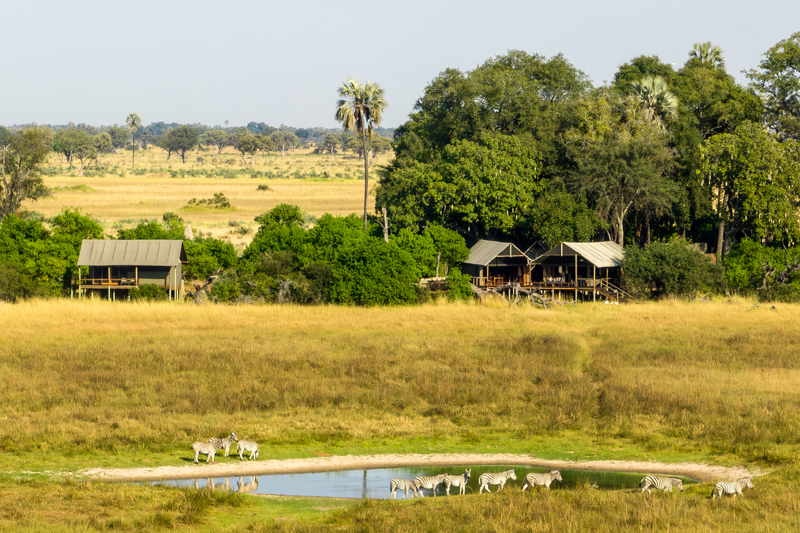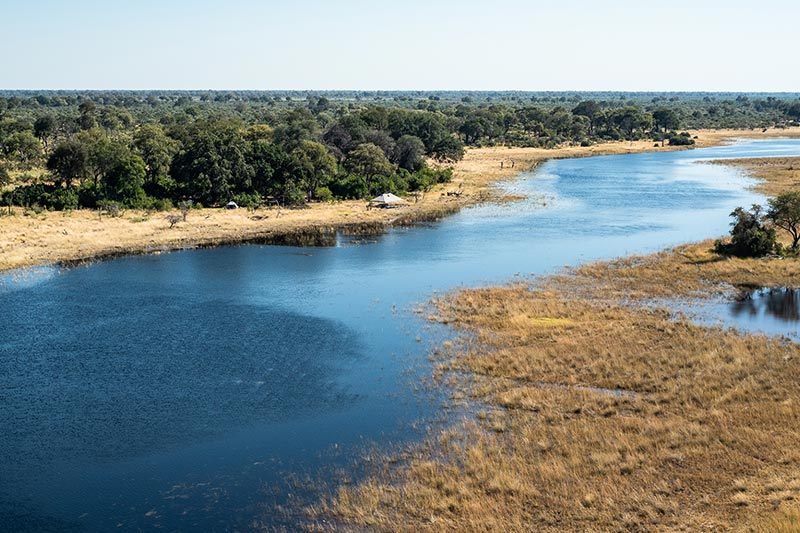Karangoma
KARANGOMA IS AN EXCLUSIVE TENTED CAMP IN THE NORTH-EASTERN REACHES OF THE OKAVANGO DELTA.
Karangoma is located on a 30,000 hectare concession, which includes 12 miles of the beautiful Selinda Spillway, set on a peninsula of woodland overlooking the open flood plains of the spillway. The camp has been built in partnership with the local Bukakhwe community and the focus here is not solely wildlife viewing, but also exploring the wilderness and learning about the local culture and conservation. Having said this, the game viewing is good with all the major predators found in the area and good herds of zebra, elephant and buffalo coming to the spillway to drink during the dry season. The location of the camp on the edge of the delta and the northern woodlands also makes for varied game viewing experiences with rarer species such as roan and sable antelope and bush pig regularly encountered. The camp itself is very comfortable, blending nicely into the natural environment, and has a relaxed, quiet and exclusive feel. This is a camp suited to travellers looking for a remote, personal and good value experience, prioritising an immersion into nature and varied activities over luxurious accommodation or constant big five encounters.
Rooms
There are six tents (one of which is a family tent) built on to timber decks, with large gauze windows, and a small verandah to the side. The family unit comprises two en suite bedrooms (one room is slightly smaller) which are connected externally. The tents are furnished with double or twin beds, two comfortable chairs, a writing desk, luggage and hanging space, ceiling fans and en suite bathrooms including a double vanity, flush loo and indoor and outdoor plumbed showers.
Central Areas
The main areas comprise a separate lounge and dining tent, both built on to a low timber deck, a communal plunge pool and a campfire.
Facilities
Wi-Fi – Yes
Power for Charging – Yes
Swimming – Yes
Habitat & Wildlife
The camp has access to the waters of the Selinda Spillway, as well as various islands and floodplains along the course of spillway, whilst to the north a vast area of woodland stretches away. The area is home to the full range of Okavango wildlife, with the exception of rhino which are very unlikely to be seen this far east. Lion, leopard, cheetah and wild dog can all be seen in this area, along side elephant, buffalo, hippo and a wide variety of plains game including zebra, eland, tsessebe, wildebeest, red lechwe, impala and the more rare roan and sable antelopes. Night drives are good for spotting nocturnal species such as genet, serval, civet, porcupine, white-tailed mongoose and African wild cat.
Activities
Guests can explore the diverse habitat by game drives (day and night), guided walks, mekoro and boat (water-based activities are subject to water levels and are usually more restricted from November through to April).
Seasons
Karangoma is open throughout the year, though the best game viewing is generally from June through to early November.
Children from eight years are accepted at Karangoma (children under 12 are not permitted on walking safaris or mokoro activities). Families with children under 12 years are required to take a private vehicle for the duration of their stay. While there is a family unit, the bedrooms do not connect internally and the focus of the camp lends itself to those travelling with older children who can participate in the range of activities and appreciate the wilderness setting.
Karangoma is partnered with the local Bukakhwe San community of the nearby village of Gudigwa and committed to conservation through reducing human wildlife conflict.
All guests staying at Karangoma pay a Community & Conservation Levy that directly contributes to the communities adjoining this area of the Okavango Delta. Support focuses on positive impacts like revenue sharing, community employment, training, and hosting eco-clubs for children.
The camp works closely with the CLAWS (Communities Living Among Wildlife Sustainably) initiative which seeks to mitigate human-wildlife conflict through collaboration with the community. The two key elements of the CLAWS approach involve introducing an innovative and sustainable communal cattle herding programmes, alongside fitting lions in the area with high-tech satellite collars which issue early warning alerts to farmers when lions move into the cattle areas. This has meant that local farmers on this northern edge of the Okavango now rarely lose cattle to stock-raiding lions, and lions in return are not under threat from poisoning.
As a result of funding from Karangoma and its guests, CLAWS has been able to expand their lion alert system, while also making plans to expand the communal herding programme – a prime example of tourism contributing to both conservation and community challenges.


















